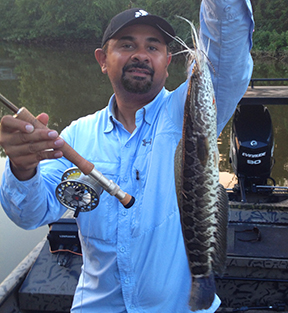 April in DC. It means cherry blossoms for many and the start of northern snakehead season for a few. Fly fisherman and archer Austin Murphy recounts his efforts to catch the snakehead in the nation’s capital river.
April in DC. It means cherry blossoms for many and the start of northern snakehead season for a few. Fly fisherman and archer Austin Murphy recounts his efforts to catch the snakehead in the nation’s capital river.
Northern snakeheads were first discovered in the Potomac River in 2004. I saw my first snakehead swimming in a tidal creek in view of the Washington Monument in 2008. In just a few years, this toothy apex predator captured the attention and imagination of many fisherman and outdoor enthusiasts.
My crew and I started with a small aluminum boat designed for shallow water, fixed with a crude lighting system and an elevated spotting platform. The onboard generator powered several high intensity lights that were designed to penetrate the water at night. We discovered that snakeheads could be arrowed at night in shallow water, where they were less active. They were often found lying on top of hydrilla mats, where the flow rates were low.
An abundance of snakeheads harvested by bow and arrow provided an excellent opportunity to learn more about their flavor profile. We fried, grilled, smoked, and broiled snakeheads and even tried to prepared a few sous vide. The firm texture, inherent sweetness, and clean finish were noteworthy features of this exceptional fish. Several chefs in the region have also prepared this invader, and we all agree: northern snakeheads are amazing table fare. The fish is now on the seasonal menu of several white-tablecloth restaurants.
For me, the thrill of stalking snakeheads at night with bow and arrow has taken a back seat to chasing them in day light hours with my fly rod. Hooking and landing snakeheads with fly gear continues to be an exciting and challenging obsession. I have learned that snakeheads are not aggressive monsters that eat just about anything. They are actually highly selective feeders that can be extremely skittish. If you’ve fly-fished for permit on coastal saltwater flats or carp in shallow river systems, you may have an idea of the difficulty involved in catching snakeheads on the fly. That said, I’ve traded in the noisy aluminum boats with lights for a stealthy carbon kevlar skiff to better my odds of success at fly fishing.
Northern snakeheads are now part of the tidal Potomac ecosystem. They stage near creek mouths in the spring and migrate to shallower water, where they breed in thick cover. In late summer, mature fish move back into deeper water. I have spent many hours creating and testing fly patterns that mimic a variety of snakehead food sources for use in various conditions. These snakehead food sources include killifish, shad, bluegill, perch, and crayfish.
My quest to understand snakeheads has connected me with many people who share deep concerns for our environment and a reluctant admiration for the snakehead’s resilience and adaptability. Many questions still remain. Will long-term studies and multivariable models provide us with a better understanding of this invasive species? Will this apex predator be harmful to the health of our native fisheries? Can we combat the invasion with our appetites?
This is one of my favorite snakehead recipes. It’s an original recipe but the cilantro and mint sauce was adapted from a family recipe that was originally created by an amazing chef, my mother, Maud Murphy.
Crispy Fried Snakehead with a Cilantro and Mint Sauce
Ingredients
2 pounds of northern snakehead filet
Peanut or canola oil for frying
Flour Mixture
2 cups all-purpose flour
¼ cup of rice flour
½ tsp. of garlic salt
½ tablespoon baking powder
½ tablespoon baking soda
Cilantro and Mint Sauce
1/2 medium white onion, finely chopped
1 tbsp. lemon juice
1 cup chopped cilantro leaves
1 cup of chopped mint leaves
1/2 tsp. cumin
1/2 tsp. cinnamon
1 cup vegetable broth
Salt & pepper to taste
1/3 cup of fresh cilantro garnish
3 tbsp. of grape seed oil (or use your own preferred oil, such as canola)
Directions
In a medium-size mixing bowl, combine the flour mixture ingredients and set aside.
Clean, wash, and dry cilantro and mint leaves and place in a mini food processor. Puree to a fragrant green paste and set aside.
Sauté finely chopped onion in grape seed oil or your preferred oil.
Add ground cumin and cinnamon and let simmer.
Add coriander and mint paste.
Add vegetable broth and lemon juice.
Let simmer and reduce to thicken sauce.
Add salt to taste.
Slice snakehead fillets into workable 2 to 3 inch pieces. Rinse and pat dry.
Transfer snakehead to the flour bowl. Dredge the fish into the flour mixture and dust off extra coating.
Deep fry by adding enough oil to a frying pan or wok to cover the fish pieces, at least 1 inch deep. I prefer to fry in peanut oil.
Heat oil to 375 degrees. Carefully set prepared fish in the oil and fry until light golden-brown.
Drain on a clean towel or paper towel.
Plate with cilantro and mint sauce. Add fresh cilantro garnish. Serve hot.


























{ 1 comment… read it below or add one }
Nice recipe, more importantly, what type of flies are you using to catch the snakehead????